 Research Article
Research Article
Multivariate Analysis for Fleece Types Classification in Argentine Llamas
Frank EN1,2*, Brodtman LI1 and Hick MH1,2
1Univ Católica de Córdoba–IRNASUS-CONICET, Argentina
2Univ Nacional de La Rioja, Sede Chamical, Argentina
Eduardo Frank, Designation Professor, Catholic University of Cordoba, UNLAR, 3555 Cordoba - Argentina.
Received Date: June 27, 2019; Published Date: July 05, 2019
Introduction
The types of cover or types of fleece have been identified in various species and breeds [1] and described in various works in cashmere-producing criollo goats [2], in alpacas [3] and in argentine Llamas [4,5]. The types of fleeces are made up of different types of fibers and at different frequencies within fiber types, in Llamas of Argentina [4]. Something similar happens with the types of fleece Huacaya and Suri in Alpacas [3].
In other species, such as sheep (Merino wool), the determination of types or styles are defined, from the textile point of view, through: the definition of the crimp of the staple or ‘character’, uniformity of the crimp, shape of the staple and of the tip, color of the contaminant, etc. [6,7,8].
It has been demonstrated that, the types of fleece defined subjectively as styles, are described objectively through different types of fibers that are differentiated by length, thickness, types of undulations, and presence-absence of luster. These macroscopic aspects are related to the types of scales, shape of the fiber and the medulla, which in turn are determined by the different types of follicles. The repeatability of objectively defined types of fleece is high and the types can be redefined as: double coated (DC), simple coated (SC) and luster (L) (standard or patterns types); hemilustre (HL) and intermediate coated (IC) as intermediates between L - SC and SC - DC respectively. The differentiation is made on the basis of the most representative types of fiber of each type of fleece without the frequency of these types of fibers having greater weight in the differentiation [9]. But, nevertheless, some doubts exist between South American Camelids breeders and fiber production researchers, who affirm that the separation is artificial (anecdotal reference).
When the classification of a particular item is a complex task is given by multiple variables or criteria, multivariate statistics is indicated to properly achieve the purpose [12]. In previous studies, this statistical methodology has been used, but only to separate the main types of fleece or patterns types (DC, SC and L) [9].
The objective of this work was to reclassify the types of fleece, previously defined, by means of the use of the greatest amount of morphological and productive variables measurable by application of the multivariate statistical methodology.
Materials and Methods
The starting of the types described fleece from phenotypically: double coated (DC), single coated (SC) and Luster (L) as patterns type; hemi luster (HL) and intermediate coated (IC) as intermediate between SC-L and SC-DC respectively [4,9].
Some 18 fleeces of the following types of fleece (TV) [4], are used: Double coated (DC, 3): Intermediate coated (IC, 4); Simple coated (SC, 4), Hemilustre (HL, 3) and Luster (L, 4). The mean diameter of total fiber (DMFT, μm) and the coefficient of variation of DMFT (CVT, %) were: DC: 21.7μm (35.6%), IC: 20.5μm (35.6%); SC: 23.3μm (27.1%), HL: 24.1μm (27.1%), L: 22.5μm (27.4%).
Four sub-samples of each type of previously defined fleece were described and their staples were dissected on velvet cloths. Previously defined types of fleeces were described based on the following visual description:
List of descriptive types of fleeces (5):
1. Double-coated fleeces (DC): guard or cover fibres highly prominent and visible, down fibres well-crimped, shorter and noticeably thinner than guard fibres.
2. Single-coated fleeces (SC): these are thick and this fibres, but all crimped. No clear differentiation between the two coats as in DC.
3. Intermediate-coated fleeces (IC): guard fibres not as visible as in DC, but also straight fibres, down fibres crimped but with similar length as the guard hairs, but they are thinner than in DC.
4. Lustre fleeces (L): Also called Suri, mostly in Alpacas. Thick and this fibres are straight, and a curled staple with thin and tapered tip can be seen.
5. Hemi lustre fleeces (HL): these are thick fibres and a great deal of straight fibres with only some of the thin fibres slightly crimped (more widely than SC).
They were separated from 10 to 20 fibers of each type of fiber (TF) spontaneously identified, totaling 961 dissected fibers. The emerged fibers were classified based on macroscopic characteristics: length, thickness, type of undulation (R/cm) and presence-absence and/or type of observable glass-opacity (luster) (shine).
Microscopic observations were added: type of medulla and its frequencies (MF), diameter of the fiber (FD) and medulla diameter (MD) and their relationships (MD/ FD) and by means of semiembedding (“cast”), the scales/100μm (SN) were counted, and the Haussman scale index (HI) expressed as SN/FD.
The height of the scale (SH) was performed by SEM according to Tonin et al. [11].
The fibers were weighed from 10 to 10 in a precision scale (0.1mg) (FW), and their densities (DF) and specific gravity (EspGrav) were calculated and the fibre frequencies (FF) were obtained.
Statistical analysis
Principal Components (PCA), Cluster (CA) and Discriminant analysis (DA) was used by InfoStat package: multivariate statistics [12].
Results and Discussion
In the PCA, 59.6%, 20.2% and 79.8% of the total variance was explained by PC1, PC2 and cumulative total, respectively. The variables FD, 1.5DS, Medulla, MD, Tex, MD/FD, Bl and PRFACTOR as opposed to HI, LUSTRE, Length, FGRUP and FL, separate in PC1 the DC types of HL and L, leaving IC and SC as intermediate. PC2 separated HL from L, IC-SC from DC based on >30, TFD, Thickness vs TFCV, HI, Sheight, EspGrav and Shine (Figure 1).
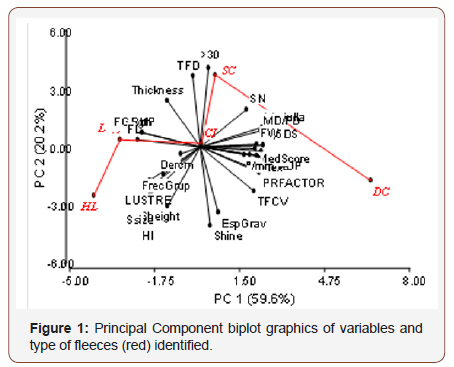
The CA, with a 60% cut line, shows separation between DC on the one hand, SC-IC and HL-L on the other. This is consistent with determined only with the type’s patterns (DC vs SC vs L) [9], extending the degree of definition achieved in such previous work (Figure 2).
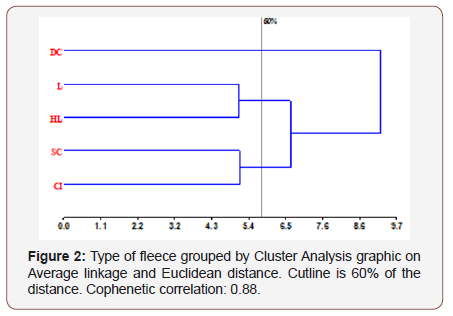
The Discriminant Analysis (DA) (Figure 3) achieves a separation in the Canonical Axis 1 (83.04%), between DC and the rest of the types of fleece, while the Canonical Axis 2 (12.17%) only achieves a smaller separation between HL-L and SC-IC. This coincides with the separations achieved in CA (Figure 2) and coincides with the morphological discriminations previously reported [4,9].
In the DA cross classification table (Table 1), the fibers of the types of DC and HL fleeces were well classified (error: 0%). The IC fibers were well assigned minus 0.67% which was poorly classified within L. The L fibers were correctly assigned all, minus 1.32%, which were poorly classified within HL. In SC, the classified fibers were all well assigned by the DA, minus 0.65% poorly assigned in IC. The average apparent error rate of the entire table is 0.64% (Table 1).
Table 1:Cross classification (apparent error rate).
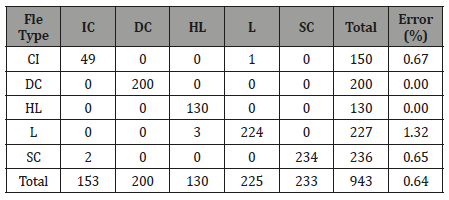
A similar discrimination in a Jackknife Matrix of classifications, was obtained in previous work, but only for the standard types (DC, SC and L), because the intermediates (HL and IC), had not been considered [9].
In previous works with multivariate statistics, a clear separation between DC and L had been achieved, with only one variant between DC and SC, but SC and L separated without difficulty [9].
When the same conceptual approach is taken from another previous work [5], but the biplot drawing of Figure 3 is superimposed on it, Figure 4 is obtained with real staple photos of the of dissected types of fleece.
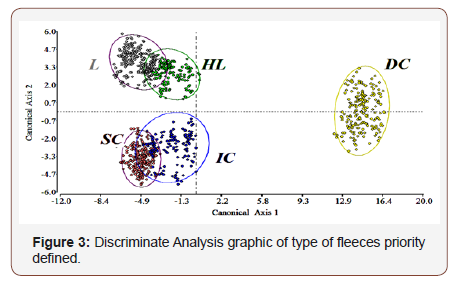
However, what Figure 4 shows, does not fully agree with the conceptual separation made by Brodtman et al. [5], in which IC is considered as intermediate between DC and SC, which is not verified in this work, where SC and IC are variants of the same type of fleece. The location in the same quadrant of HL and L is totally coincident with what she draws in that work [5] (Figure 4).
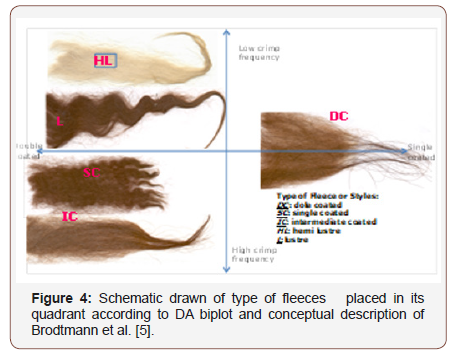
A simple visual separation (as shown in the photos) is possible between HL-L and between SC-IC, although the clearest separation and without any doubt is between both groups and DC. This is possible with a probable error control about 80%. For higher precision in this discrimination, in addition to the degree of visualization of the double-coated or the frequency of the fiber crimp, all the variables used in this Multivariate Analysis and their interrelation should be considered [13-15].
Conclusion
The types of fleeces previously defined are well discriminated through the variables measured and using the multivariate statistics, grouping closely together Single Coated and Intermediate coated, Hemi Lustre and lustre and separate double coated very far.
The existence of the types of fleece is real and quantifiable. Therefore, it is important to consider its existence and obviously its classification is recommended before being processed the Argentine Llama fiber.
Acknowledgement
None.
Conflict of Interest
No conflict of interest.
References
- Dry FW (1975) Massey Univ. Palmerston North, New Zealand, p. 300.
- Frank EN, Hick MV, Russano D, Castillo MF, Prieto A, et al. 2010. Small Rumin. Res. 150: 60–69.
- Villarroel L (1991) In: Fernandez- Baca, (edts) Avances y Perspectivas del Conocimiento de los Camélidos Sud Americanos. of. Regional de FAO, Santiago, Chile. pp.363–387.
- Frank EN, Hick MV, Adot O (2007) Descriptive differential attributes of type of fleeces in Llama fibre and its textile consequence: 1 – Descriptive aspects. The Journal of The Textile Institute 98(3): 251-259.
- Brodtmann LI, Hick MH, Castillo MF, Frank EN (2017) Conceptual description of the llama fleece structure and the potential of classing and dehairing. Textile Research Journal 88(12): 1384-1401.
- Winston CR (1989) Wool Tech and Sheep Breed 37(1): 27–32
- Jackson N, Rottenbury RA (1994) Style Metrology. Specification of Australian Wool and its implications for Marketing and Processing, CSIRO and IWS, Sidney, p. 14.
- Stevens D, Crowe DW (1994) Style and Processing Effects. Specification of Australian Wool and its Implications for Marketing and Processing, CSIRO and IWS, Sidney, p.22.
- Frank EN (2001) Ph.D. Thesis, Bs As. Univ. Argentina.
- Adot OG, de Cossio A.P, Maguire A (2008) South American Camelids res. 2: 359 - 366.
- Frank EN, Hick MV, Castillo MF, Seghetti Frondizi DG (2019) Effect on Textile Behavior of Fleece Types and Dehairing Process on the Linear Density and Regularity of Yarn from Argentine Llama Fibre. Journal of Textile Science & Fashion Technology 2(2): 1-3.
- Tabachnik BG, Fiddel LS (1996) Using Multivariate Statistics (3rd edn) Harper Collings.
- Tonin C, Innocenti R, Bianchetto MY, Pozzo PD (1996) In: Gerken M, Renieri C (2nd edn) 2nd Eur Symp on SAC, pp 291-300.
- Hillbrick LK (2012) Ph.D. Thesis, Deakin University, Australia.
- Di Rienzo JA, Guzman AW, Casanoves F (2002) A multiple-comparisons method based on the distribution of the root node distance of a binary tree. Journal of Agricultural, Biological, and Environmental Statistics 7(2): 129-142.
-
Frank EN, Brodtman LI, Hick MH. Multivariate Analysis for Fleece Types Classification in Argentine Llamas. J Textile Sci & Fashion Tech. 3(1): 2019. JTSFT.MS.ID.000555.
-
Multivariate, Fleece types, Llamas, Fiber types, Textile, luster, Dehairing, Yarn
-

This work is licensed under a Creative Commons Attribution-NonCommercial 4.0 International License.






